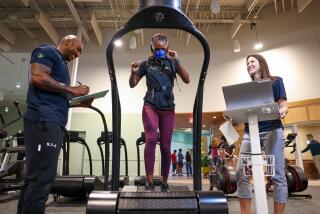Hospitals, Exercisers Profit by Fitness : Health: In programs for the general public, medical centers have found a strong source of revenue.
After suffering more than 20 years from arthritis in both her knees, Irene White became convinced that an exercise program would relieve her pain. But the 93-year-old couldn’t see herself joining the high energy, spandex-clad, buns-of-steel set found at many commercial gyms.
White found both the services she needed and a more comfortable, low-key atmosphere at Daniel Freeman Memorial Hospital’s fitness center. For a mere $165 a year, she enjoys personalized attention from Daniel Freeman’s physical therapists and exercise counselors three times a week. And after several months of aquatic aerobics, White says her pain has been reduced significantly. “All I can say is that it’s better late than never.”
White, although older than the Inglewood center’s typical client, is one of a growing number of people turning to fitness centers affiliated with hospitals. Some need specialized exercise programs, but many others are joining for routine physical fitness.
The number of hospital-affiliated fitness centers blossomed in the 1980s as many hospitals looked for extra sources of revenue. They were considered a bold move for the conservative hospital industry, but most of the fitness centers have proved profitable, and in many cases they have helped compensate for losses in other hospital operations, according to John Greene, executive director of the Assn. of Hospital Health and Fitness Centers, based in Evanston, Ill. Currently, there are about 1,000 such gyms around the nation. But the growth has slowed in the 1990s because the threat of health care reform and major changes in the industry have pushed hospitals back into a conservative mode--especially in California, said David Langness, a spokesman for the Hospital Council of Southern California.
But Langness said he believes the tide is turning again in favor of a growth in hospital fitness centers. “Companies used to shop for price, not benefits, and any frills were cut out to save costs,” he said. “We’re seeing a major shift now in terms of an emphasis on wellness rather than sickness,” he said, explaining that more companies are now willing to subsidize employee fitness programs. In fact, Daniel Freeman receives some support from some corporations that subsidize employees who use the facility for routine exercise.
*
“The hospital industry has not been very aggressive on the prevention aspect of health care,” said Greene, but it does have competitive advantages in marketing its programs. “When you join a hospital health care center, you get a better level of personal attention and guidance from properly trained professionals,” he said.
Commercial fitness centers and gyms, naturally, are not eager to see any more hospital affiliated fitness centers. Many commercial club owners say hospitals are unfair competition because they benefit directly or indirectly from taxpayer support.
“Our private members should not have to compete with subsidized entities,” said Irma Campbell-Cook, executive director of the Portland, Ore.-based Northwest Athletic Club Assn., which represents 90 clubs in the West. “We want a level playing field.”
Although hospitals claim that their facilities attract people who would not ordinarily patronize a gym, Campbell-Cook said they are indeed competing for many of the same customers and offer some of the same services. Many of the gyms in her group have older clients and have had to offer specialized programs to remain competitive with hospital facilities, she said.
Hospital fitness centers “see us as sweatshops for a small portion of the population, but if they visited one of our clubs, they would see that that’s not the case,” Campbell-Cook said.
Hospitals and the commercial industry are not always in competition. South Bay Hospital in Redondo Beach helps recruit clients for private clubs. South Bay, funded partly by Los Angeles County taxpayers through the Beach Cities Health District, offers residents or employees of Manhattan Beach, Redondo Beach and Hermosa Beach the opportunity to enroll in short-term health awareness programs at its fitness center. After a program lasting no longer than four weeks, South Bay clients are encouraged to enroll in a health club program.
“We introduce people to a gym who would normally not go and then send them to the private gyms,” said program director Paula Neubert. Because of the hospital’s funding, Neubert said, “legally, we cannot get into competition with private health clubs in the area.”
According to AHHFC, hospital fitness centers are typically smaller than private clubs and only 20% of their members previously worked out at commercial clubs.
The Daniel Freeman fitness center was originally built in 1982 for Freeman doctors, but it gradually was opened to patients who needed physical therapy and to members of the public.
Today, the fitness center offers its 800 clients facilities for swimming, weight lifting, aerobics, basketball and racquetball in addition to the special programs for people in need of rehabilitation services.
The fitness center operates as a regular department of the hospital, and whatever profits it makes, though limited, go back to the hospital, according to supervisor Susan Stohrer.
Jerry Volland, 70, is a two-time graduate of the fitness center’s cardiac rehabilitation program. He joined the center in 1984 for a short period after suffering a heart attack and rejoined in 1990 after a second heart attack, which he attributed to having canceled his first membership.
“My doctor recommended it, and I’m sure it has helped me quite a bit,” Volland said. The fitness center staff “gets on you if you miss a few days, and I need that kind of prodding,” he said.
More to Read
Inside the business of entertainment
The Wide Shot brings you news, analysis and insights on everything from streaming wars to production — and what it all means for the future.
You may occasionally receive promotional content from the Los Angeles Times.










